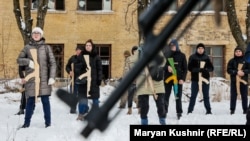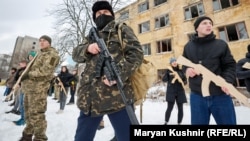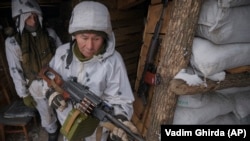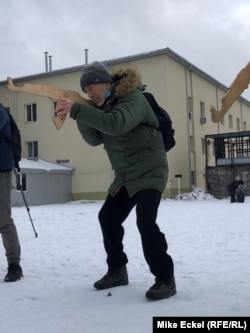KYIV -- Weapons training, which featured a piece of pressed composite wood cut in the shape of a rifle, was going well for 18-year-old Anna Kuksa until she pivoted to her left, as ordered by her camouflaged trainer. One of her fellow students turned to the right, and they collided and tripped over each other.
Thirty minutes later, Kuksa and her friend Maria, whose painted green fingernails and panda-bear knapsack contrasted with the fatigues and patterned backpacks of the other participants, took a break from the cold. They laughed off the incident.
“We’re in a war situation now. We need to defend not just the country but our home city. We have to know how to act if Russia attacks,” said Kuksa, a student at a Kyiv medical college. “This is what we need to do -- what everyone needs to do.”
And so, on a snowy Sunday morning with temperatures hovering at freezing and puddles of slush tormenting pedestrians, several hundred people -- mostly men, many in camouflage or all-black clothing -- stood at attention on the grounds of an abandoned heavy machinery factory on Kyiv’s western outskirts, yelling, “Glory to Ukraine!” when called on.
Their mission: drilling on what to do if Russia launches what some Western officials say could be the biggest military action in Europe since World War II.
In recent months, civil-defense training has mushroomed, in Kyiv and in other major cities, as Russia has menaced Ukraine with more than 100,000 troops deployed to its north, east, and south, along with some of its most sophisticated weaponry.
Some of it is being done through formal institutions like the Territorial Defense Forces, whose training is directly overseen by the Ukrainian Army.
But some is being done through once-private militia groups and political organizations that played a major role in the early years of the fighting against Russia-backed separatist forces in the eastern Donbas region after 2014. At that time, Ukraine’s badly depleted and demoralized armed forces struggled to withstand their onslaughts.
That includes National Corps, a far-right political organization that has drawn into its ranks veterans of some of Ukraine’s more notorious right-wing paramilitaries, including the Azov Battalion.
National Corps itself was labeled as a “nationalist hate group” in a 2018 U.S. State Department report. In papers filed in 2018 in a U.S. federal court, the FBI noted Azov’s “association with neo-Nazi ideology and use of Nazi symbolism” and said it “is believed to have participated in training and radicalizing United States-based white supremacy organizations.”
“This is just one of numerous examples that illustrate that the government of Ukraine embraces far-right forces, including internationally active forces like the Azov movement,” said Oleksiy Kuzmenko, a U.S.-based journalist and researcher who has written extensively about Ukrainian right-wing groups.
Asked for a similar comparison in another Western country, Kuzmenko pointed to Patriot Front, a U.S. white supremacist group.
“It would be like the Patriot Front having their own 1,100-strong unit in the U.S. Army and having a close relationship with Democrats and Republicans and being welcome on CNN,” he told RFE/RL.
National Corps
Founded in 2016 by Andriy Biletskiy, National Corps counts veterans of the Azov Battalion among its core supporters. Azov itself was incorporated into the Ukrainian National Guard as a way to formalize command over, and funding for, the disparate paramilitaries that fought against Russia-backed separatists in the early years of the war in the Donbas.
In his early writings in the 2000s, Biletsky openly espoused Nazi-like themes and ideology. In one pamphlet that he penned in 2007, he talks about “Social-Nationalism” raising “ancient Ukrainian Aryan values.… Only their revival and implementation by a group of fanatical fighters can lead to the final victory of European civilization in the world struggle. “
He gained renown in mid-2014 when he was at the forefront of a battle to take back the port city of Mariupol from Russia-backed separatists. The Azov Battalion, which has espoused neo-Nazi sympathies, shot to prominence in that and other fighting.
Biletskiy was elected to Ukraine’s parliament that year. Ukraine’s National Guard, meanwhile, started bringing militias like Azov under formal government oversight.
But by 2019, however, Biletsky’s party failed, along with other right-wing political groups, to win any seats in parliament.
Biletsky, who maintains a prominent public voice accusing the government of negligence in preparing the country for war, did not attend the January 30 training.
Asked about National Corps’ ties with Azov, one of his chief deputies, Maksym Zhorin, called the persistent reports about extremist ideology “a product of Russian propaganda and disinformation” aimed at discrediting it.
He insisted that National Corps was now completely separate from Azov.
“Preparation for war should not be considered from a political point of view,” Zhorin told reporters. “We look at it only from the point of view of the defense of the state.
“The first thing we have to do is prepare the local population, prepare the army, prepare the economy. And all the politics -- that’s all in the background,” he said.
He accused the Ukrainian government of doing too little to prepare civilians for the possibility of an invasion by Russian forces. Asked about a new invasion, Zhorin said: “It will happen. It’s just a question of time.”
Guns…And First Aid
President Volodymyr Zelenskiy’s government did push through a law formalizing a civilian defense-type organization. That law, called On The Foundations Of The National Resistance, came into force on January 1, setting up the Territorial Defense Forces.
The plan envisions 25 brigades in nearly all of the country’s administrative regions, with plans to recruit 130,000 reservists. Last year, army units started holding small-scale weekend sessions for civilian volunteers.
But for critics of the government, especially groups like National Corps, it’s too little, too late. And private organizations and paramilitary groups like National Corps or the Ukrainian Legion have stepped up to conduct their own training sessions -- which in some cases can double as recruiting events.
“Of course, at first people come and they want to learn how to shoot weapons,” said Oleksiy Sannikov, who heads Ukrainian Legion, a private group that does not have a political arm and has been organizing trainings since 2014. “But then we have to explain to them that it’s just as important to know how to do first aid, how to aid others, how to behave in a group setting.”
The January 30 training at the former ATEK factory in western Kyiv featured around 400 people, a motley crew that mixed university students and older men and women wearing street clothes suited for sidewalk strolling, with seasoned veterans wearing camouflage fatigues or young men wearing all black clothing, including black balaclavas.
Among the veterans, some from Azov units, several displayed arm patches with symbols of white supremacist and Nazi groups.
Smoke from barrel fires drifted through the ruined buildings and courtyards, as a more experienced group practiced storming an abandoned building. A less experienced group was handed composite wood cutouts of rifles and then drilled in how to pivot and stand when aiming the rifle at a target.
Some wearing sneakers slipped in the snow as they practiced pivoting right and left, holding the wooden guns. Some bounced up and down to stay warm and blew on their fingers. All listened intently as the instructor showed them how to look down the sights of the rifle.
“We all know what happened in 2014. There was no military recruitment. No one knew what to do. The officers were idiots,” said Danylo Hrabovskiy, a 21-year-old student training at a Kyiv-area aviation engineering institute.
People who did volunteer to fight ended up being sent to the Donbas front lines, where many died needlessly, said Hrabovskiy, who expects to be commissioned as a lieutenant and deployed in a combat unit when he finishes his schooling.
For example, he said, volunteers did not have proper field and emergency medical training -- like how to apply a proper tourniquet -- so they died of blood loss.
Hrabovskiy said he and other volunteers were frustrated by Ukrainian weapons laws, which include onerous regulations for people wanting to have a gun in their own homes. He said it’s totally unrealistic for volunteers trained in civil defense to drive 20 minutes to a district armory to get their weapons in the event of war.






